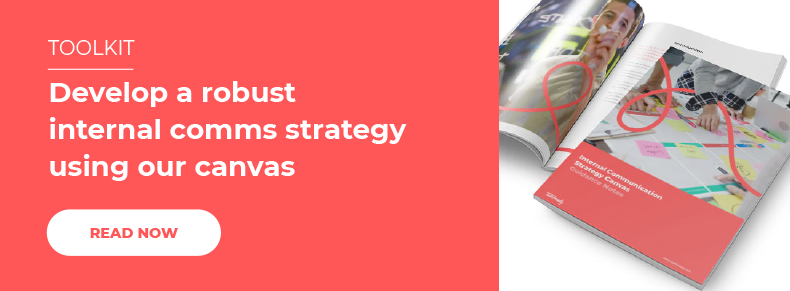Digital transformation is happening all around us. Companies are adopting advanced technological tools in order to operate more effectively, and internal communications are at the centre of this change. The increased responsibility to effectively connect with
employees, both frontline and office-based, has placed internal communications at the top of everyone’s to-do list.
With a greater choice of communication tools now available, businesses are beginning to explore new ways to communicate and engage with their employees. This raises the question: what is an intranet? Has the company intranet become an outmoded form of communication, or is it still relevant in today’s digitally-enhanced world?
Intranet definition
We need to start by exploring the intranet meaning in all its various forms. In its most simple form, an intranet is a private network used by companies to communicate exclusively with their employees. What is the core element of the intranet definition? It’s all to do with the high privacy levels of the network and the fact that only internal access is granted. Essentially, it is a closed system of communication.
What is the intranet used for? In its traditional form, it is used by employers to communicate across the organisation, and by employees to search for company information and updates. However, as we will discuss in greater depth, the modern employee intranet is evolving to become so much more than an information conduit. So, when we ask what an intranet is used for, the answer is now much more complex and far-reaching.
What’s the difference? - Intranet vs internet
What does intranet mean, and what’s the difference between the two? An intranet is a private network, only accessible to the organisation’s workforce. On the other hand, the internet is a public entity, available to anyone and everyone.
What’s the difference? - Intranet vs extranet
How does an intranet differ from an extranet? It’s all about privacy again. An intranet exclusively limits access to its workforce. However, an extranet can also be accessed by authorised third parties, such as partners, clients and vendors.
Why the poor reputation?
According to recent research by the International Association for Human Resource Information Management IHRIM, 85% of companies have an intranet or employee portal. Clearly, the need to communicate exclusively with the workforce is of prime importance. So why do intranets have such a poor reputation amongst both organisations and their employees?
The statistics speak for themselves. A survey by Prescient revealed that 57% of employees see no purpose in their company intranet, and only 13% of employees reported participating in their intranet on a daily basis. Even worse, almost a third of employees never access their intranet at all.
Key intranet disadvantages
There are many disadvantages associated with the traditional company intranet:
1. Outdated content
Unless you have built regular updates into your strategy for your intranet, it can quickly become obsolete. Not only do you then run the risk of employees using inaccurate or out-of-date information, but you will also find that the intranet is no longer a trusted source.
2. Poor structure
An intranet that is hard to navigate has already failed in its primary objective. Without an organised structure, your intranet will not be able to deliver. If staff don’t know where to search for information, they will soon stop looking for it.
3. Bugs and errors
Software issues can cause intranet usage to drop through the floor. As soon as employees associate the intranet with technical problems such as crashing and freezing, they will be reluctant to use it. Even worse, if the bugs cause data corruption, your intranet will actually be working against you.
4. Failure to engage
The most effective communication tools are ones that connect with their audience. However, intranets often overlook the need to engage with employees in favour of disseminating news, reports and information.
5. Inadequate security
External threats are often well covered with firewalls and virus protection. However, internal issues such as weak passwords, unlimited access, poor encryption and remote access problems from insecure personal devices all need to be addressed.
6. Unclear ownership
Who’s in charge? Often, the answer is no one in particular. When ownership is shared across departments, with no overall responsibility assigned, your employee intranet becomes a rudderless ship at sea without overall goals or direction.
7. No evaluation
Unless you measure impact, it is almost impossible to quantify success and justify continued investment. Most company intranets are left unmonitored.
8. Low user adoption
“If you build it, they will come.” Sadly, this isn’t true of traditional intranets. In fact, the most common challenge faced by intranets is low usage. It is very common to find your intranet is not reaching the whole company.
The evolution of intranets
What is a company intranet? It’s practically unrecognisable now from its first incarnation. The world has changed dramatically since the first intranet came on the scene. So, it’s no surprise that the corporate intranet has transformed over time, keeping pace with technology and business requirements.
Let’s take a quick look at the evolution of intranets. What does intranet mean to us in 2022, as opposed to the very first intranets back in the 1990s?
1990-2000 - Internal website
The very first incarnation of the company intranet began as just a simple internal website. It used the same technology as the company’s external website, and access was limited to employees only. What was this basic style of intranet used for? It provided simple pages and links to company information, usually based on templates. Some offered a basic functionality for delivering corporate news. Unsurprisingly, these early intranets were often poorly maintained and only provided a one-way communication channel.
2000-2010 – Workforce portal
The concept of integrating with intranet with other employee services came into play at the turn of the century. By integrating other applications, such as personnel, sales and client systems, employees could now perform limited job-related tasks on the intranet. However, the portal software proved expensive and often failed to deliver a simplified route for employees. This version of the intranet was still a one-way street of information and provided no opportunity for the employee voice to be heard.
2010-2018 – Social network
In line with the rise of social media in the mainstream, companies began to integrate social elements into their intranet sites. The intranet became a two-way communication channel, inviting interaction and feedback from employees. Online communities were created, encouraging collaboration and teamwork between colleagues. This was a huge step forward, but such intranets were rarely accessible away from the office desktop, limiting their use and reducing their reach.
2018-present – Employee app
Finally, the employee intranet became a mobile experience. This new development for intranet platforms transformed the traditional, static intranet into a dynamic, engaging experience. By bringing the intranet to remote and frontline employees, as well as the desk-based staff, the intranet was finally meeting its target of connecting across the entire workforce. With the employee experience at its heart, the employee app makes the intranet a relevant and proactive communication tool.
The question of integration
How does an intranet work with other well-established platforms such as Microsoft Teams and Sharepoint? The answer is simple. The modern intranet can be seamlessly integrated with other platforms to provide an all-encompassing solution for your workforce.
Online collaboration
While the intranets based on the social network model offer collaboration platforms, these have since been eclipsed by team chat solutions such as Teams and Slack. The intranet is no longer considered the prime tool for online collaboration. Instead, the new mobile intranet works alongside this software, providing an enhanced community experience and personalisation.
Document management
Companies requiring a robust document management tool to enable collaboration on the development of documents will probably already be using a solution such as Sharepoint. So what is an intranet used for in this scenario? The modern employee intranet operates seamlessly alongside these platforms, providing integration with your existing framework.
Key requirements of the modern intranet
The employee intranet of 2022 is a truly dynamic tool that reaches across the entire company. It helps you connect with those hard-to-reach employees who have previously remained outside the communication loop. It’s also unfailing relevant and up-to-date, personalised to every employee and a genuinely effective two-way communication channel. Let’s take a closer look at what makes a good intranet.
1. It should be accessible to every employee
You’re looking for a mobile intranet platform that puts the workplace in your people’s pockets. It needs to reach seamlessly across your entire organisation, connecting with every employee. Whether your employees are working on IOS, Android or Safari, it should be fully compatible with multiple operating systems. Allowing employees to use their favourite means of communication, whichever device, app or platform they prefer, will remove all barriers to entry.
What to look for: A mobile solution that connects with employees, whether at home, at work or on the road.
2. It should build trust with strong company branding
With so much information readily available, it’s essential to make sure employees can recognise official company content. Your employee intranet needs to reinforce a solid internal brand for maximum transparency. Whether you reinforce your identity with company colours or take the brand experience to the max with a fully customised app, what makes a good intranet is absolute clarity. A dedicated company news channel, branded and personalised, will deliver a platform that employees can trust
What to look for: An option to implement personalised company branding, thereby creating clarity and trust for your employees.
3. It should offer personal and valuable content
It’s worth remembering that employees have to choose to use the intranet. Your intranet needs to provide a range of information that is personalised to the employee and designed to engage. What is a corporate intranet that really works? You need to deliver a dynamic blend of channels that provide information, share knowledge and encourage interaction. Keep communications relevant by filtering content and using video and podcasts to create a more diverse experience for employees.
What to look for: A platform that delivers relevant, up-to-date and personalised information to create instant engagement.
4. It should instantly distribute urgent information
Your employee intranet should be proactive, with the capabilities to deliver information in the moment. When you need to contact your workforce with high priority updates, you need a channel that instantly delivers. Look for a solution that offers push notifications that reach everyone simultaneously, wherever they are, whatever they’re doing. You’ll need a platform that can target information too; send out direct messages to specific teams, create dedicated group conversations, or message the whole company.
What to look for: The provision of instant notifications will give you the power to reach employees when it really matters.
5. It should provide employee feedback opportunities
What is an intranet used for? Delivering information, yes. But it should also be a channel for receiving information. Is your intranet giving employees a chance to speak up and be heard?
Look for a platform that invites opinions and comments and acknowledges your employees’ feedback. It should provide a social platform for company discussions, where employees can meet, chat and share knowledge. A modern intranet will also offer social tools to share and celebrate successes.
What to look for: An effective two-way feedback channel that gives employees an opportunity to be heard.
6. It should deliver measurable results
How well does your intranet work? Is it achieving the desired result? Unless you measure the impact of your internal communications, you won’t know if they’re succeeding. By tracking engagement levels, you’ll have a much clearer picture. You need software that lets you download reports and logs for external analysis and company reports. It should be simple to pre-schedule regular pulses and polls, ensuring you gather a consistent stream of feedback.
What to look for: Software that keeps a close eye on the impact of your communications with integrated monitoring and reporting tools.
Conclusion
It’s clear that the modern employee intranet has evolved beyond recognition from its early days as a simple news and information channel. So, what is an intranet in its current setting? It’s a mobile platform that truly connects with your employees, wherever they are. Incorporating company branding, up-to-date content, feedback opportunities, and instant notifications an employee intranet is the ultimate solution for distributing information and sharing knowledge across the organisation.









.jpg)
.jpg)